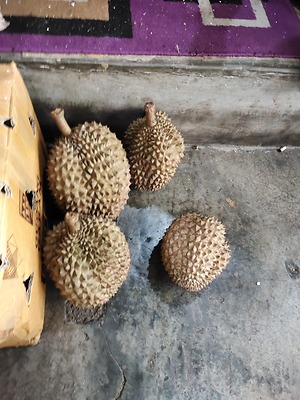


Bawor Durian
Estimated Inventory, 1 EA : 0
Description/Taste
Bawor durians are large fruits, averaging 6 to 9 kilograms, and can weigh as heavy as 15 kilograms with an oval to oblong shape. The fruit's surface is entirely covered in sharp, angular spikes and generally ranges in color from light tan to brown. Underneath the spikes, the skin can be split to reveal an ivory, spongy interior encasing multiple lobes of flesh. The yellow to orange flesh is soft, creamy, and thick, filled with a few oval, flat, and thin seeds. Bawor durians have a pungent aroma and are highly valued for their smooth and dense, custard-like consistency. The flesh has an initially sweet, rich, and tropical flavor followed by a savory, sulfurous, metallic, and bitter finish.
Seasons/Availability
Bawor durians are available in Indonesia's wet season, with a peak harvest in January and February.
Current Facts
Bawor durians are botanically a part of the Durio genus and are an Indonesian variety belonging to the Malvaceae family. The fruits were created from multiple graftings of local and imported durian varieties in Banyumas, Central Java, and were selected for their thick, dense flesh and bittersweet flavor. Bawor durian trees are also characteristically small, resistant to disease, and are unaffected by weather fluctuations, valued as a home garden variety producing up to 40 fruits multiple times a year. In the modern-day, Bawor durians are an Indonesian cultivar seen as a direct competitor to other notoriously expensive Southeast Asian durians such as monthong and musang king. Bawor durians are often referred to as “Indonesia’s monthong,” which is the name of a famous Thai durian cultivar, and the beloved variety is primarily consumed fresh as a luxury fruit. Many Bawor trees can also be seen in the yards of Banyumas residents as the variety was a part of an economic program to promote conservation and provide additional sources of income. A bank in Indonesia known as Bank BRI developed a Corporate Social Responsibility group that distributed Bawor durian seeds to the residents of Banyumas for home garden planting as a way to stimulate the economy.
Nutritional Value
Bawor durians are an excellent source of potassium to balance fluid levels within the body, phosphorus to develop bones, and magnesium to maintain optimal nerve functioning. The fruits are also a good source of vitamin C to strengthen the immune system, fiber to stimulate the digestive tract, and contain lower amounts of calcium, iron, vitamin A, zinc, and vitamin B6
Applications
Bawor durians are primarily consumed fresh to showcase the fruit’s thick and soft consistency. The spiny husk can be cut with a knife, torn open, and the flesh can be consumed straight, out-of-hand. Bawor durians can also be blended into juices, salad dressings, and smoothies, or sliced and incorporated into soups and curries. In Indonesia, durian is sometimes included in sayur rebus, a soup made from boiled vegetables. Bawor durians can also be incorporated into baked goods, ice cream, candy, and other desserts. In addition to the flesh, the seeds can be consumed cooked and are typically boiled or roasted. The cooked seeds are also ground into a powder and used as a type of flour. Bawor durians pair well with avocado, other tropical fruits, including coconut, mango, jackfruit, guava, bananas, and pineapple, vanilla, condensed milk, ginger, garlic, and chile peppers. Whole, unsliced Bawor durians will generally keep 1 to 3 days, but it is important to note that durians have a reputation for spoiling quickly, and each fruit will vary in lasting ability depending on the degree of ripeness. The flesh can also be removed from the husk and stored in an airtight container for 4 to 5 days in the refrigerator, or it can be wrapped in plastic, sealed in a bag, and frozen for 1 to 2 months.
Ethnic/Cultural Info
Bawor durians are named after the well-known character Carub Bawor in the traditional Javanese shadow puppet theater wayang kulit. Carub Bawor was introduced as a punakawan, or clown character in the 1920s, and is a sibling to the famous Indonesian character Petruk, which is also a name of a popular durian variety. Bawor was created as a puppet to connect with Central Java residents as the character is slightly different from the others, displaying clever traits mixed with direct thoughts. Bawor also represents the region’s unique cultural identity. Beyond the shadow puppet character, the name Bawor roughly translates to mean “mixed” and represents the durian’s history, being bred from multiple local and foreign cultivars.
Geography/History
Bawor durians are native to the district of Banyumas in the province of Central Java, Indonesia. The relatively new variety was developed by Sarno Ahmad Darsono and was released in 2000. Darsono is an elementary school teacher with a passion for durian, which can be traced back to his childhood when he searched for durians with his father. In 1996, Darsono used the montong durian tree to graft multiple types of local durians and began splicing over twenty different varieties. Over time, Darsono’s grafted trees began fruiting and produced 30 to 40 fruits with varying characteristics. In 2000, Bawor durians were selected from this harvest and were officially named as a new variety for cultivation. Today Bawor durians are still grown in Banyumas, and the seeds and fruits can be purchased directly through local growers at farms and roadside stands. The variety is also grown in the city of Kediri in East Java, and the fruits are sold through vendors in West, Central, and East Java.
Recipe Ideas
Recipes that include Bawor Durian. One
















